This is one versatile little dish! Classically Japanese, you’ve probably eaten nasu dengaku at a restaurant or in Japan before. Now cook it easily at home – it’s naturally vegan, cooked in 10 minutes and perfect served as an entree, a side or as the main star.
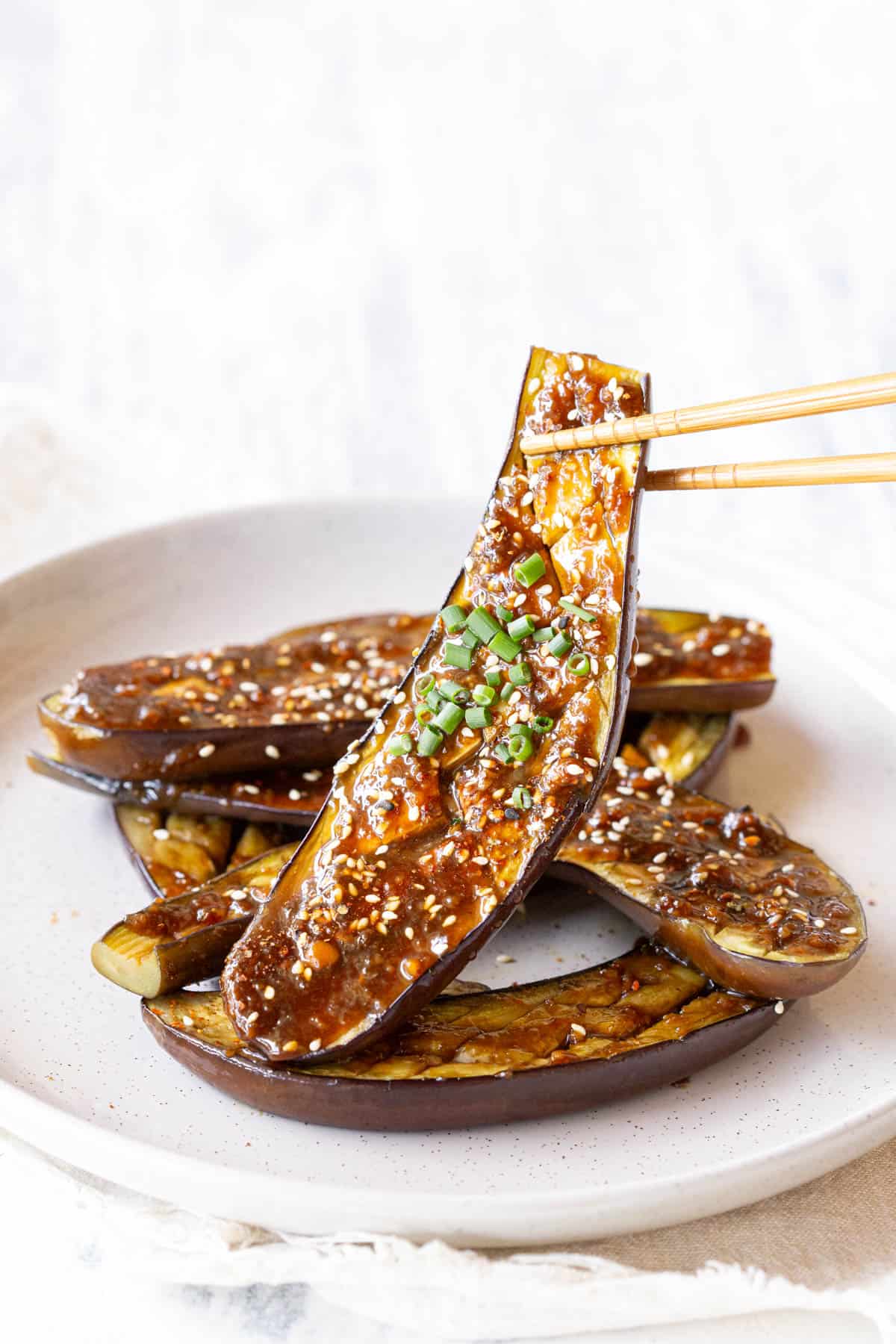
In This Post You’ll Learn
Why We Love This
These amazing Japanese eggplants are soft and melty, slathered in an irresistibly sweet and savoury miso sauce glaze. The flavour is so good you’ll want to lick the plate clean!
You can serve it hot or cold depending on the season. The miso dengaku sauce lasts for ages and goes with so many other dishes! Keep reading for more amazing serving ideas.
Related: Miso Glazed Salmon / Karniyarik (Turkish Eggplant)
Leftover Miso Glaze?
Use the sauce on just about anything! It’s often served with other grilled dishes – so try slathering it on grilled tofu, chicken skewers or salmon. It’s great with rice cake skewers (Japanese style dango or Korean tteokkochi) or even grilled konnyaku skewers. It would also be a great dipping sauce for Japanese oden stew (especially good with the simmered daikon!) or Vietnamese rice paper rolls!
For something completely different, try adding it as a seasoning for Japanese burgers, Aussie rissoles or hamburger steaks.
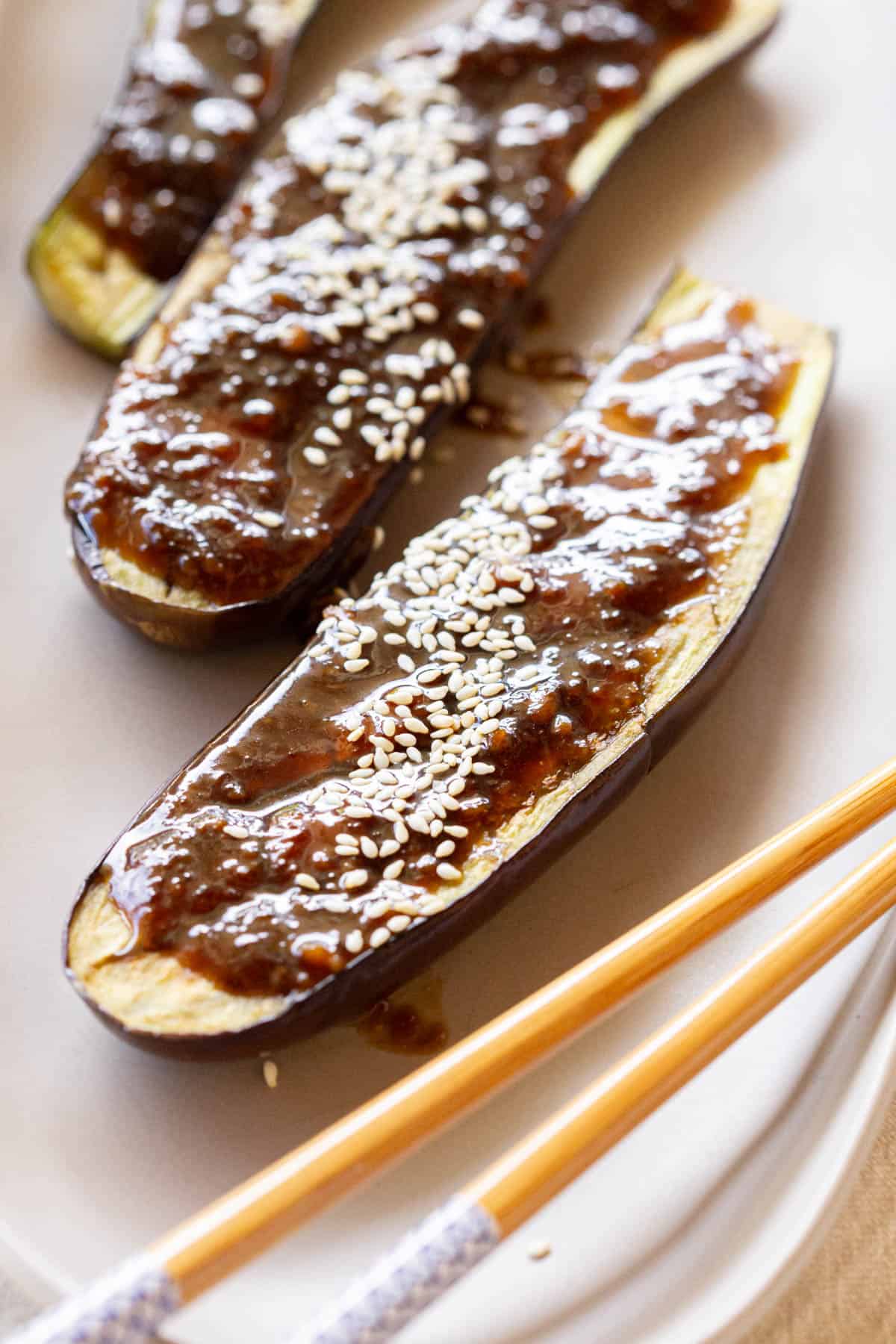
What is Nasu Dengaku?
Nasu dengaku (なす田楽) is a Japanese dish consisting of grilled, fried or roasted eggplants / aubergines (nasu) served with a sweet miso sauce (dengaku).
It’s often served as a side dish, but could be enjoyed as a main alongside a portion of rice.
What You’ll Need
- Eggplants – This recipe works well with thinner style Japanese, Lebanese or European eggplant varieties, so feel free to use whichever type is available in your area. We used home-grown eggplants from our friend’s garden!
- Vegetable + Sesame Oil – This recipe uses vegetable oil mixed with toasted sesame oil for extra flavour. Don’t have sesame oil? Make some at home with our quick homemade sesame oil recipe or just leave it out.
- Miso Sauce Ingredients – Along with sugar, you’ll need mirin (sweet cooking wine), soy sauce and miso paste (we used white which is sweeter, but red is more traditional). Look for them in the Asian or International aisle at larger supermarkets or head to your closed Asian grocery store.
- Optional Garnishes– Sprinkle with toasted sesame seeds, shichimi togarashi and thinly sliced spring onion / green onion. Another traditional garnish for this dish is thinly sliced shiso leaves if you can source them.
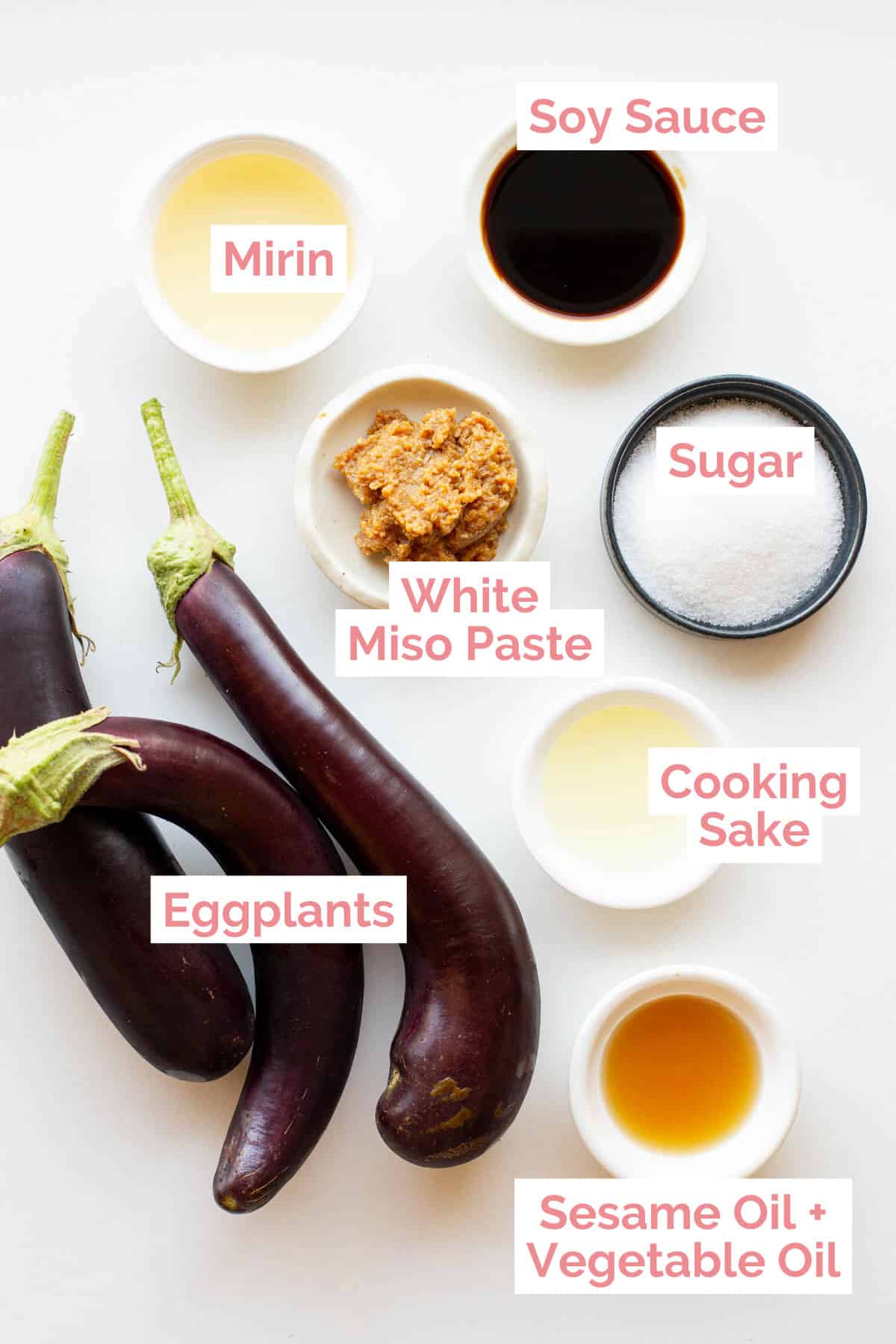
How to Make Japanese Miso Glazed Eggplant
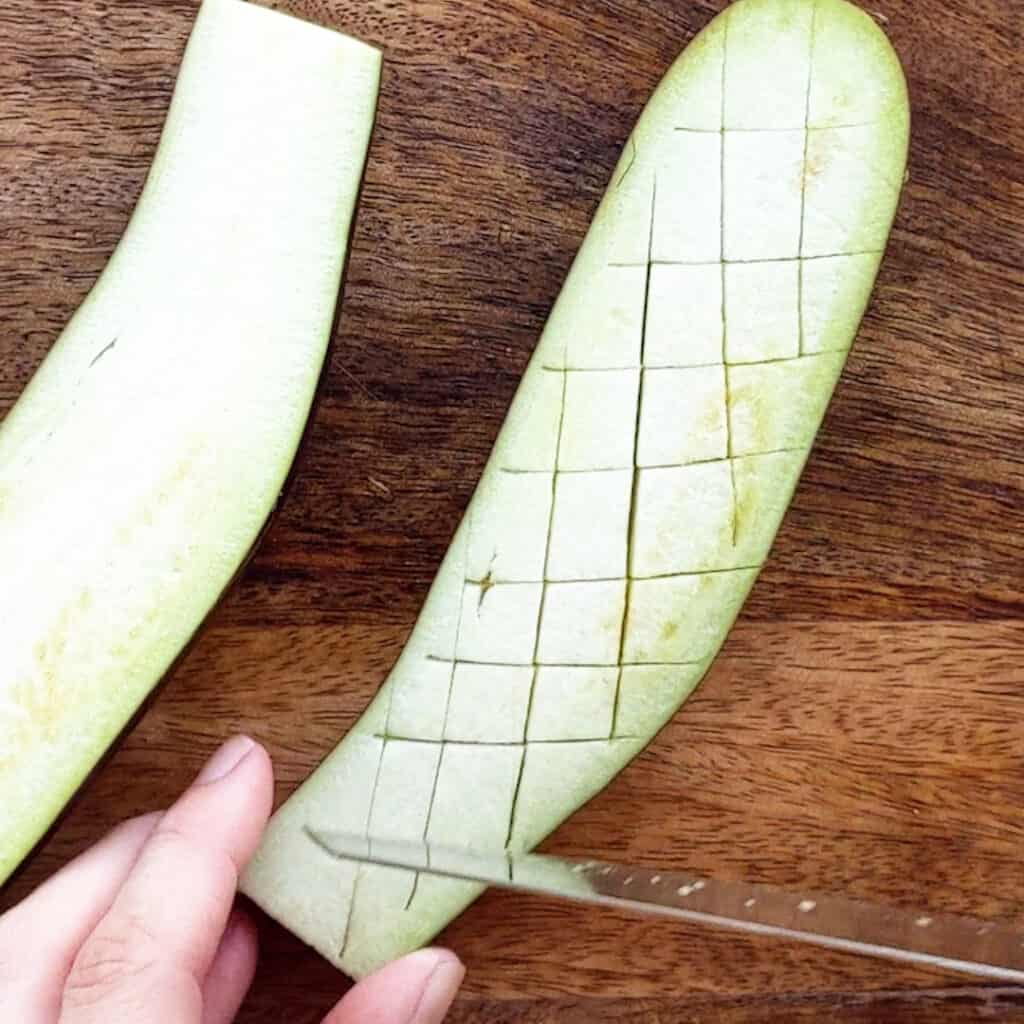
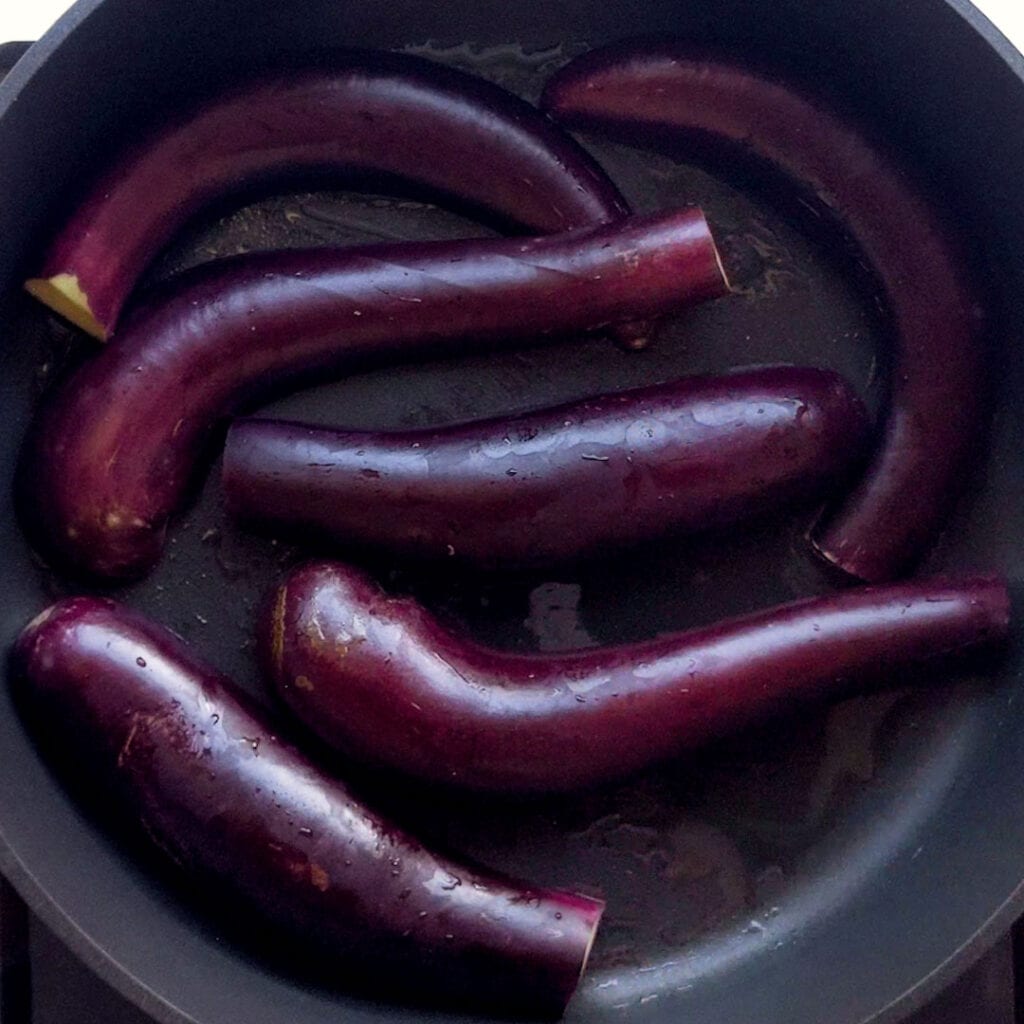

First, gather your ingredients: See recipe card below for measurements.
- Remove the green tips of the eggplant, then slice in half. Next, cut a cross hatch pattern into the flesh, being careful not to cut through the skin.
- Heat the sesame oil and vegetable oil in a large frying pan or skillet over medium heat. Add eggplants sliced side down.
- Cook for 3-5 minutes to brown. Pour in water, and cook for another 3-5 minutes (optional: add lid for extra steaming) to soften.
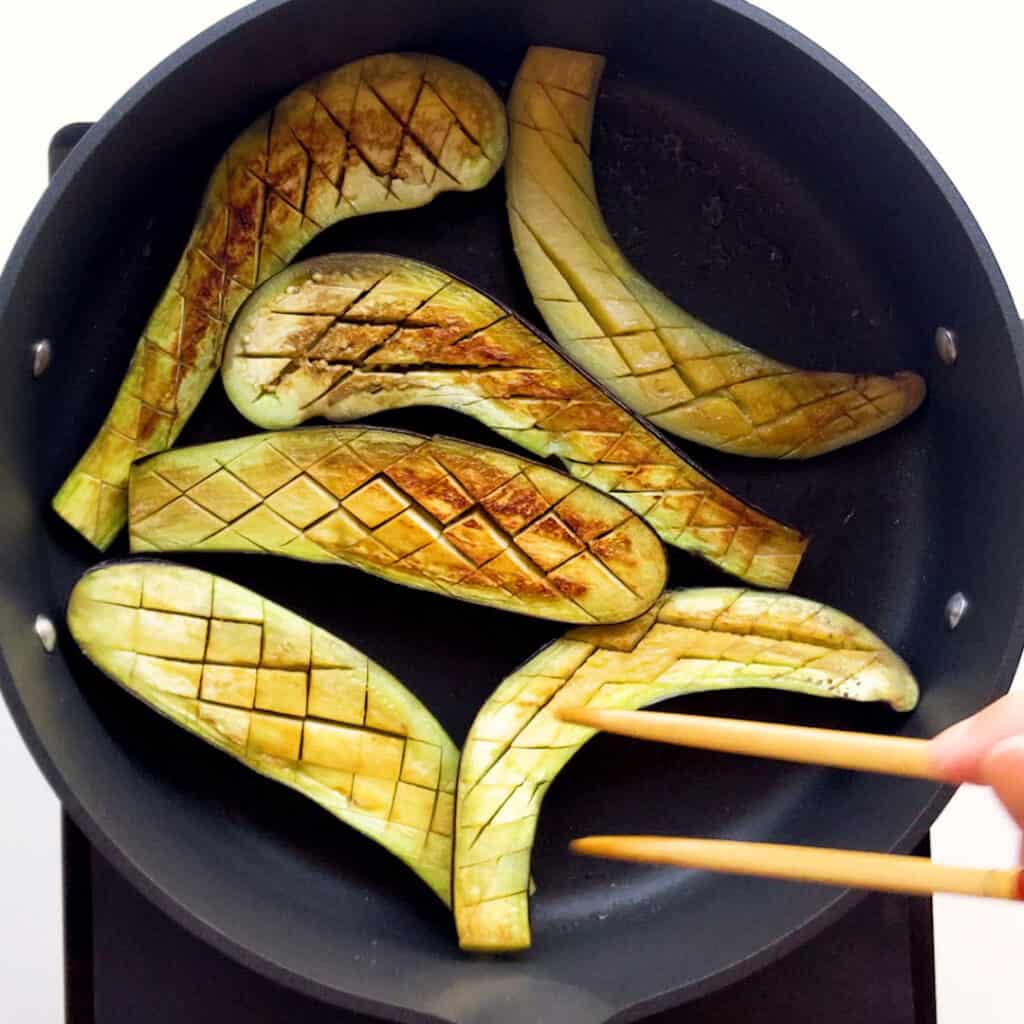
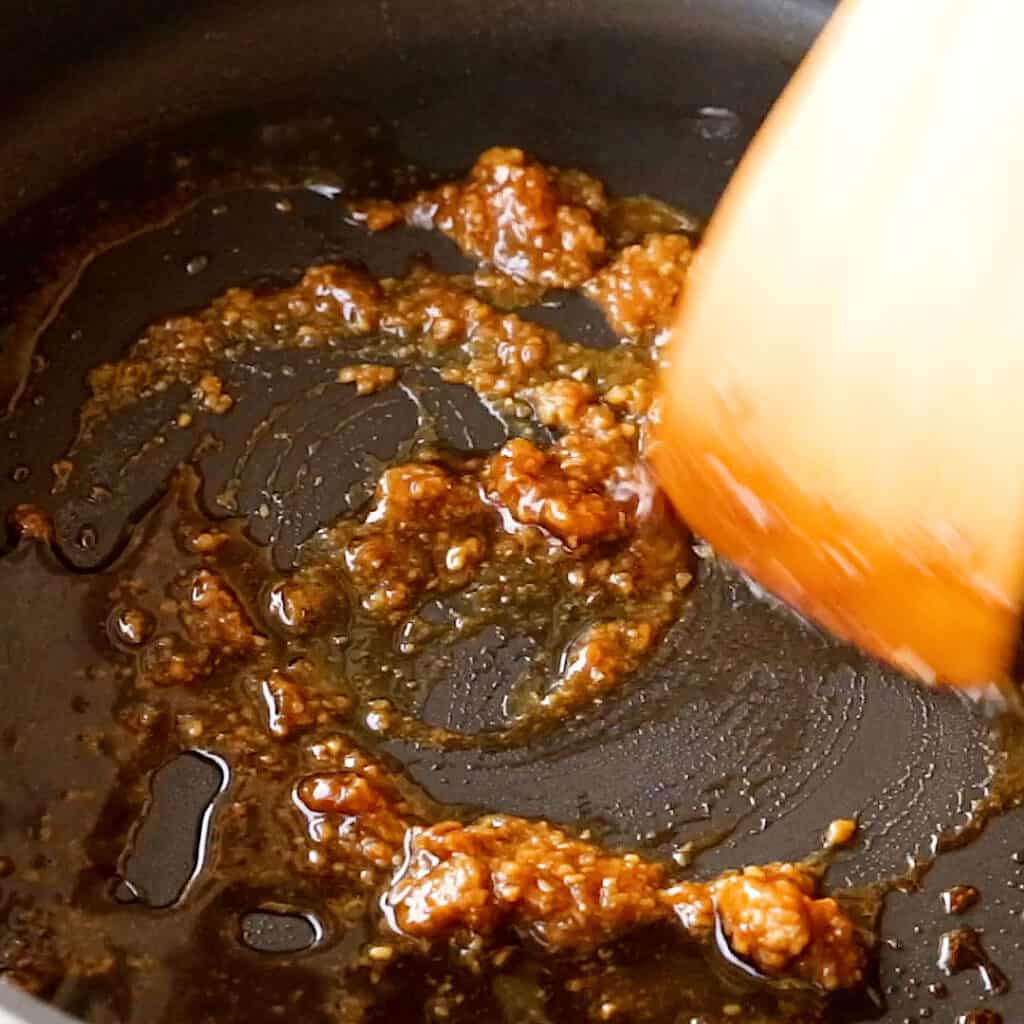
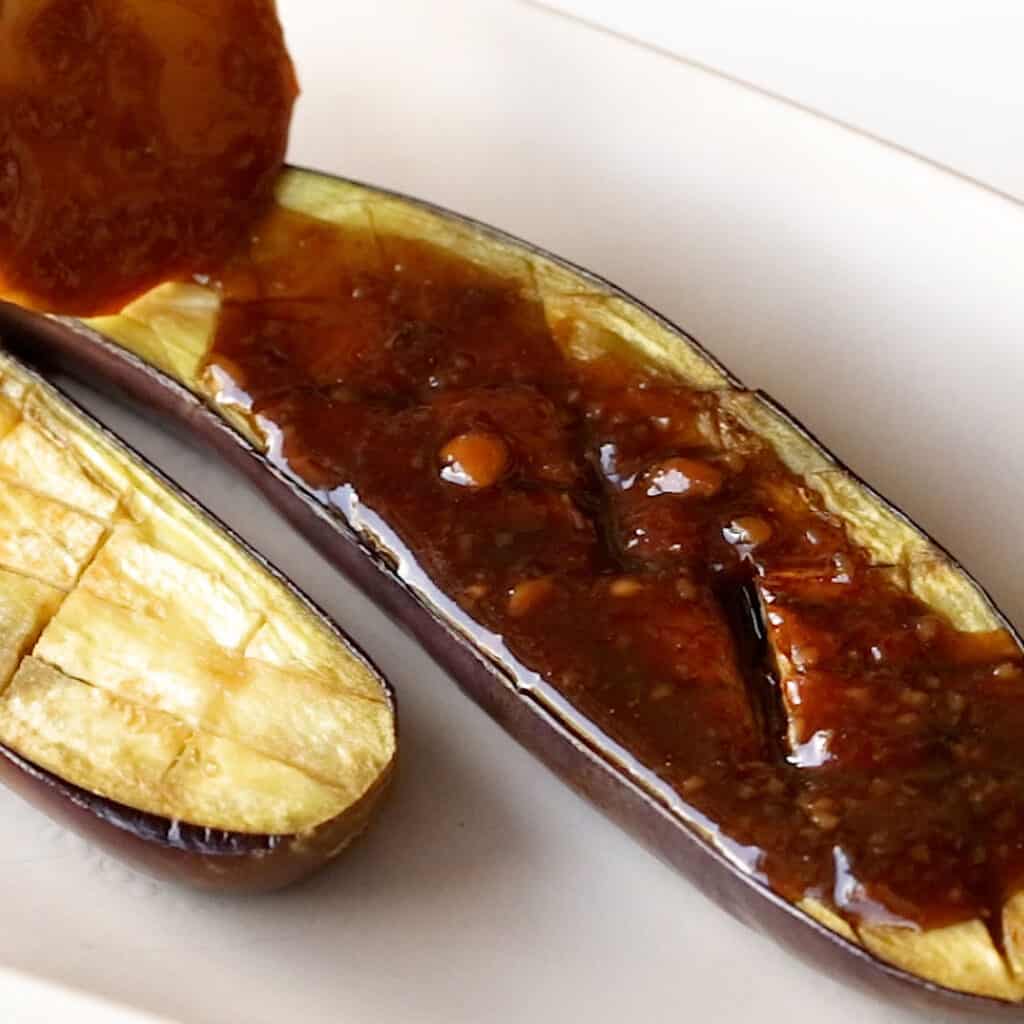
- Flip eggplant onto skin side down and brown for 2 more minutes, then remove from the pan and onto a serving platter.
For the dengaku – miso glaze sauce
- In the same pan add the mirin, sugar, soy sauce and white miso paste over low-medium heat. Mix around until it bubbles and thickens (around 30 seconds – 1 minute), then remove from the heat and drizzle over the eggplant slices.
- Optional: Garnish with things such as spring onion / green onion, white sesame seeds, shichimi togarashi and rayu chilli oil.
Wandercook’s Tips
- Cooking Time – Our recipe is tailored to slender eggplants like Japanese, Lebanese and Italian varieties. If you’re using thicker eggplants, note that they will take longer to fully cook and soften, so adjust the cooking time where necessary.
- Texture – Cook the eggplants just long enough to soften and brown the flesh without turning them into mush.
- Miso Flavour – White miso is milder and sweeter, while red miso is more intense in flavour. Choose whichever will suit you best (or use half / half if you prefer!). You can also balance out the flavour by adding a little more sugar or mirin if your miso glaze is too intense.
Storage, Freezing & Reheating
For the best flavour use up leftover eggplant within 1-2 days (keep them in an airtight container in the fridge). We don’t recommend freezing this recipe.
Any unused sauce will last a lot longer in the fridge, so pop it in an airtight container or glass jar and keep it on hand for other recipes!
FAQs
This helps them cook faster and absorb all the flavours from cooking and the miso glaze.
Yep, you sure can.
Microwave: Start with around 5 mins in the microwave, then keep cooking in short bursts if needed until softened.
Bake: Heat your oven to 180˚C / 356˚F and place your eggplants (skin side down) on a baking tray lined with baking paper. Cook for around 20 mins, adding the miso glaze in the last 5 minutes of cooking. For extra caramelised flavour, broil instead for the last 5 minutes after glazing.
Thinner eggplant varieties tend to be much softer once cooked, so you can eat the skins as well as the flesh.
If you’re cooking with larger eggplants, chances are the skin will become tough after cooking. If so, don’t worry! Just scoop out and eat the tender flesh inside, then add the skins to your compost / green waste.
Serving Ideas & Variations
- Serving Ideas – Nasu dengaku works great as a side dish alongside a serve of cooked white rice / sushi rice (or on top of a rice bowl), alongside miso soup or kenchinjiru (Japanese vegetable soup).
- Alt Presentation – Slice into thick rounds instead of in half lengthways or cut them into small chunks and place on skewers for a bite sized version.
- BBQ – Try grilling them on the BBQ instead for extra char!
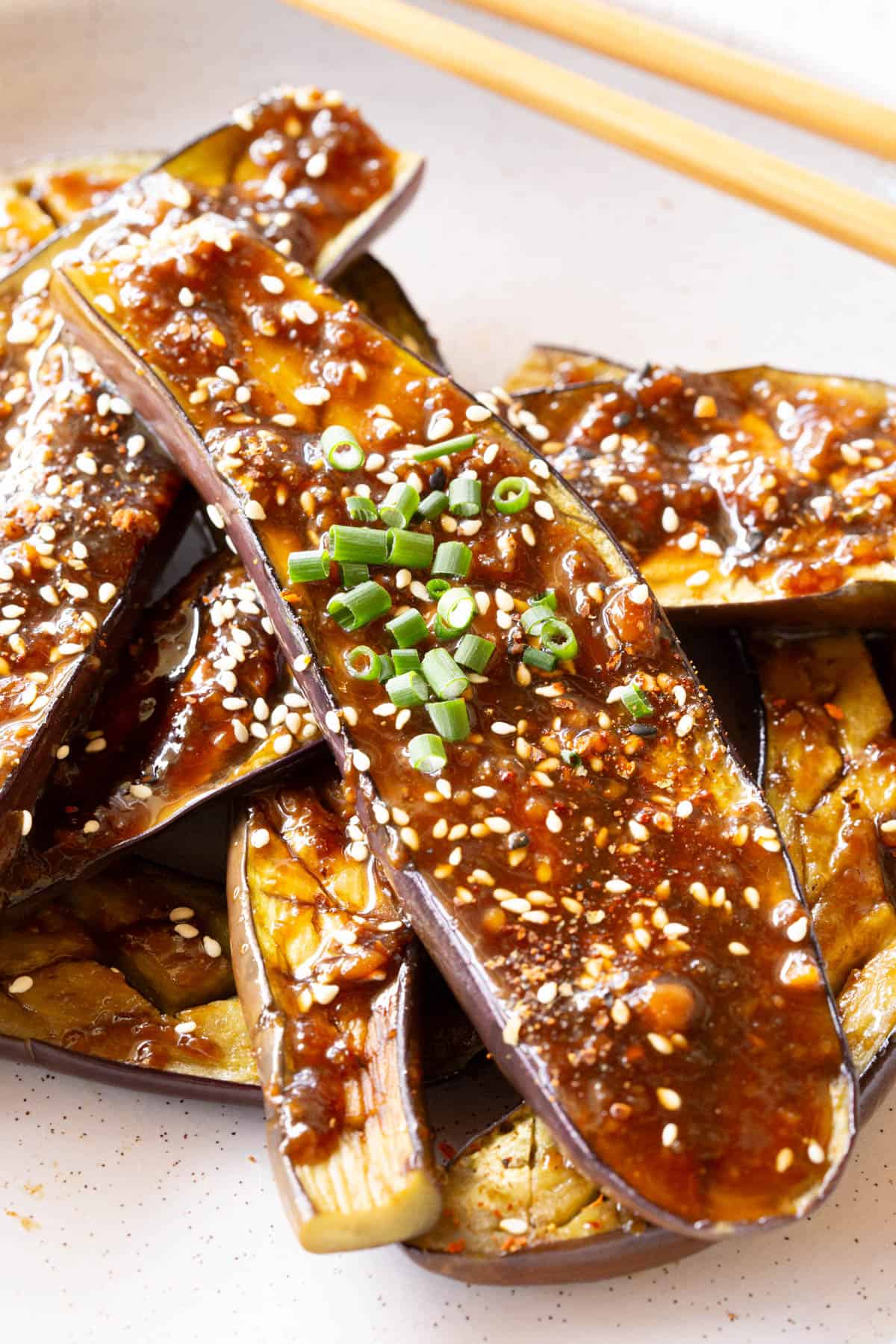
Try these amazing recipes next:
★ Did you make this recipe? Please leave a comment and a star rating below!
Ingredients
- 300 g eggplant 10.58 oz, Japanese or Lebanese
- 1 tbsp sesame oil
- 1 tbsp vegetable oil
- 2 tbsp water
For the dengaku – miso glaze sauce
- 2 tbsp mirin
- 1 ½ tbsp sugar
- 1 tbsp soy sauce
- 1 ½ tbsp white miso paste sub red
Instructions
For the eggplants
- Remove the green tips of the 300 g eggplant, then slice in half. Next, cut a cross hatch pattern into the flesh, being careful not to cut through the skin.
- Heat the 1 tbsp sesame oil and 1 tbsp vegetable oil in a large frying pan or skillet over medium heat. Add eggplants sliced side down.
- Cook for 3-5 minutes to brown. Pour in 2 tbsp water, and cook for another 3-5 minutes (optional: add lid for extra steaming) to soften.
- Flip eggplant onto skin side down and brown for 2 more minutes, then remove from the pan and onto a serving platter.
For the sauce
- In the same pan add the 2 tbsp mirin, 1 ½ tbsp sugar, 1 tbsp soy sauce and 1 ½ tbsp white miso paste over low-medium heat. Mix around until it bubbles and thickens (around 30 seconds – 1 minute), then remove from the heat and drizzle over the eggplant slices.
- Optional: Garnish with things such as spring onion / green onion, white sesame seeds, shichimi togarashi and rayu chilli oil.
Video
Recipe Notes
- Cooking Time – Our recipe is tailored to slender eggplants like Japanese, Lebanese and Italian varieties. If you’re using thicker eggplants, note that they will take longer to fully cook and soften, so adjust the cooking time where necessary.
- Texture – Cook the eggplants just long enough to soften and brown the flesh without turning them into mush.
- Miso Flavour – White miso is milder and sweeter, while red miso is more intense in flavour. Choose whichever will suit you best (or use half / half if you prefer!). You can also balance out the flavour by adding a little more sugar or mirin if your miso glaze is too intense.
- Serving Ideas – Nasu dengaku works great as a side dish alongside a serve of cooked white rice / sushi rice (or on top of a rice bowl), alongside miso soup or kenchinjiru (Japanese vegetable soup).
-
- Alt Presentation – Slice into thick rounds instead of in half lengthways or cut them into small chunks and place on skewers for a bite sized version.
Nutrition
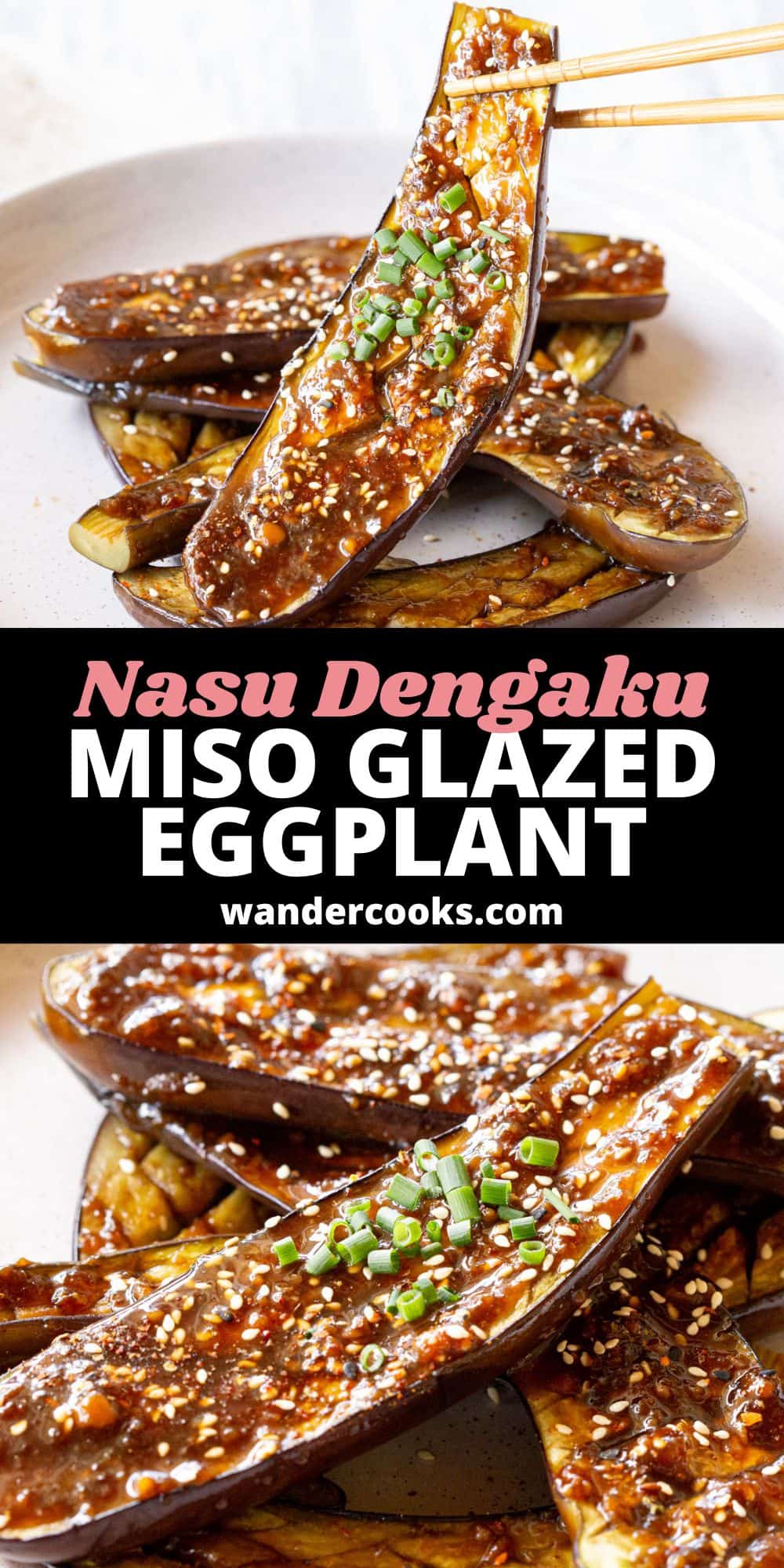

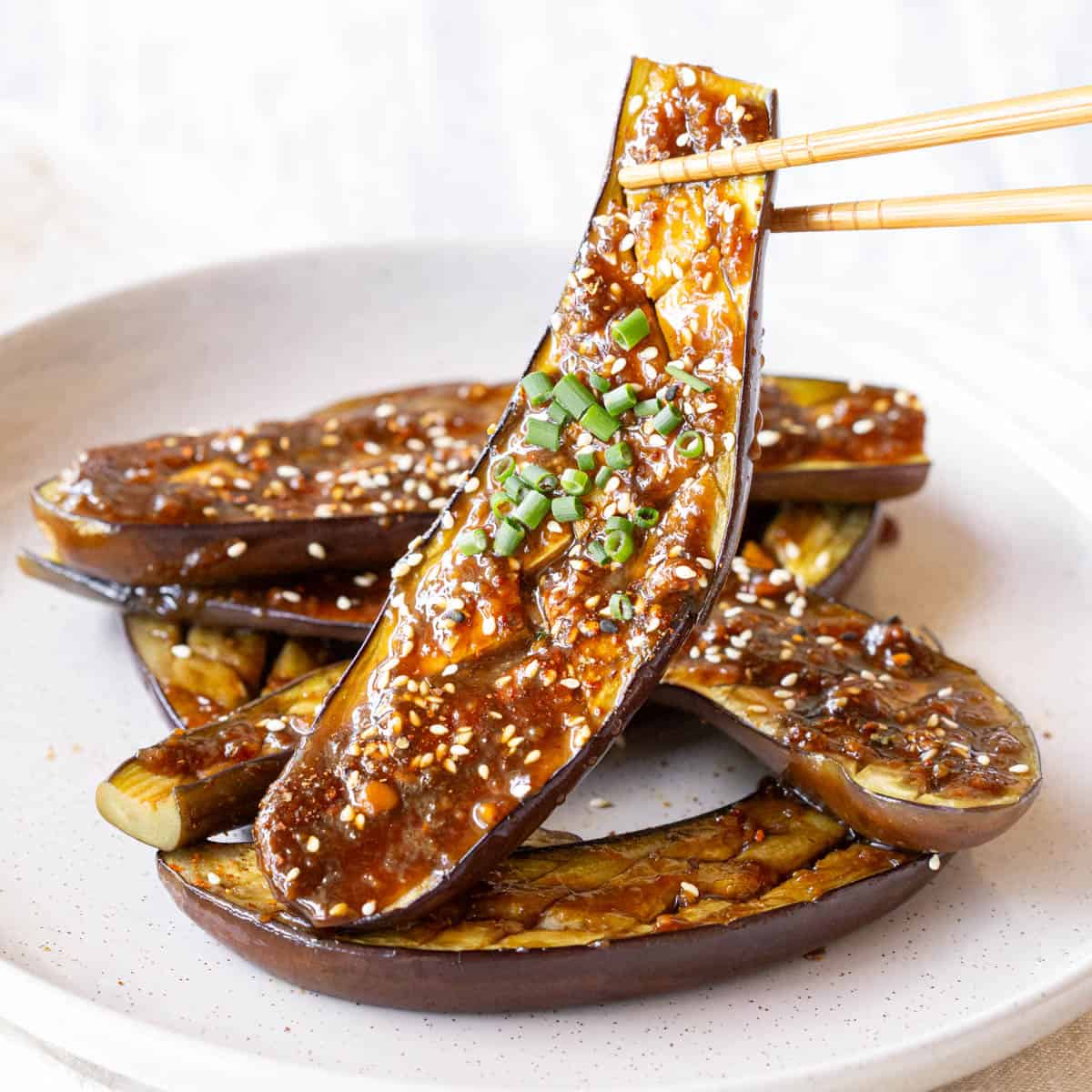



No Comments